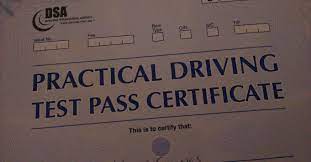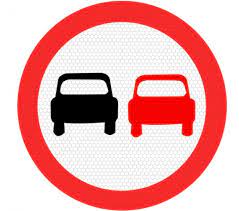
What is Dead Ground?
Definition of Dead Ground in the Context of Driving
Dead ground refers to an area of the road that is not visible to the driver due to various factors such as the position of the vehicle, other vehicles, or obstructions. It is essentially a blind spot that can pose potential dangers to drivers. Dead ground can occur in front of the vehicle, obstructing the driver’s view of the road ahead. This is mainly caused by dip or hump in the road ahead preventing you from seeing whole road ahead, as well as the curvature of the road. It is crucial for drivers to be aware of dead ground as it can contain potential hazards that are not visible until the driver is close to them.
Importance of Understanding Dead Ground for UK Learner Drivers
Understanding dead ground is of utmost importance for UK learner drivers as it plays a significant role in ensuring their safety on the roads. By being aware of dead ground, learners can anticipate potential hazards, allowing them to be more vigilant and cautious while driving. This knowledge empowers learners to make informed decisions, such as when to slow down or adjust spped, in order to avoid potential hazards. It also helps them develop a proactive approach to driving, where they constantly assess their surroundings and take necessary precautions.
Implications of Dead Ground for Drivers
Dead ground can have serious implications for drivers if not taken into account. The lack of visibility in dead ground areas can lead to dangerous situations and accidents. For instance, if a driver is unaware of a blind spot caused by dead ground, they may not be able to see an approaching vehicle, pedestrian, or cyclist, potentially resulting in a collision. Similarly, if there is an obstruction in the dead ground area, such as a broken-down car or a large dead animal, drivers who are unaware of it may not be able to react in time, leading to accidents or hazards.
To mitigate the risks associated with dead ground, drivers should take necessary precautions. This includes regularly checking their mirrors to be aware of their surroundings, releasing the gas to slow down and maintain control, and applying defensive driving techniques by constantly thinking “what if?” and being prepared for potential hazards. It is also important for drivers to use the MSPSL (Mirror, Signal, Position, Speed, Look) routine when approaching dead ground. This routine involves checking the mirrors, signalling if necessary, adjusting the position of the vehicle, reducing speed, and carefully observing the area for any potential hazards.
In conclusion, dead ground refers to areas of the road that are not visible to the driver due to various factors. Understanding dead ground is crucial for UK learner drivers as it helps them anticipate potential blind spots and obstructions, enabling them to make informed decisions and stay safe on the roads. The implications of dead ground for drivers can be serious, as it can lead to accidents and hazards if not taken into account. By being aware of dead ground and taking necessary precautions, drivers can mitigate the risks associated with it and ensure their safety while driving.
How to Identify Dead Ground
Signs and Indicators of Dead Ground While Driving
When driving, there maybe signs that will warn you the dead ground ahead, such as a red rimmed triangular warning sign with a white background and an exclamation mark in the centre, with the words “Hidden dip” in a white box situated the main sign. Also poor visibility ahead due he dip in the road or obstructions such as trees, buildings, or other vehicles. These obstructions can block the driver’s view of the road ahead, making it difficult to see potential hazards.
Importance of Being Able to Identify Dead Ground for Safe Driving
Being able to identify dead ground is crucial for safe driving because it allows you to anticipate potential hazards and take appropriate action. By recognising signs and indicators of dead ground, you can adjust your driving behaviour and be prepared for any unexpected obstacles or dangers that may arise.
Identifying dead ground helps you maintain control of your vehicle and make informed decisions on the road. It allows you to adjust your speed, position, and driving technique to ensure your safety and the safety of others. By being aware of potential hazards hidden in dead ground, you can minimise the risk of accidents and collisions.
Overall, the ability to identify dead ground is an essential skill for safe driving. It enables you to anticipate and respond to potential hazards effectively, ensuring a smoother and safer driving experience.
Risks and Dangers of Dead Ground
Potential Risks and Dangers of Not Understanding Dead Ground
Not understanding dead ground can pose several risks and dangers for drivers. Dead ground refers to areas of the road that are not visible to the driver due to physical obstructions such as hills, bends, or buildings. These obstructions can obstruct the driver’s line of sight, making it difficult to anticipate potential hazards. Some potential risks and dangers of not understanding dead ground include:
- Collisions with other vehicles: When driving in an area of dead ground, the driver may be unable to see other vehicles that are hidden from view. This lack of visibility can prevent the driver from reacting in time to avoid a collision, increasing the risk of accidents.
- Collisions with pedestrians or cyclists: Dead ground can also hide pedestrians or cyclists from the driver’s view. If the driver is unaware of their presence, they may not be able to react in time to avoid a collision, potentially causing serious harm to the pedestrians or cyclists.
- Collisions with animals: Similarly, dead ground can conceal animals on the road, making it difficult for drivers to see them and react accordingly. This can lead to collisions with animals, posing a risk to both the driver and the animal.
Importance of Being Aware of the Risks Associated with Dead Ground
It is crucial for drivers to be aware of the risks associated with dead ground to ensure their safety and the safety of others on the road. Understanding the risks allows drivers to take appropriate precautions and make informed decisions while driving. Some reasons why it is important to be aware of the risks associated with dead ground include:
- Prevention of accidents: By understanding the risks of dead ground, drivers can be more cautious and attentive when approaching areas with limited visibility. This can help prevent accidents by allowing drivers to anticipate potential hazards and take appropriate actions to avoid them.
- Enhanced situational awareness: Awareness of the risks associated with dead ground can improve a driver’s overall situational awareness. By being mindful of potential obstructions and hazards, drivers can adjust their driving behaviour and be prepared to react quickly if necessary.
- Compliance with road safety regulations: Being aware of the risks associated with dead ground is essential for complying with road safety regulations. Drivers are expected to exercise due care and attention while driving, and understanding the risks of dead ground is an integral part of fulfilling this responsibility.
In conclusion, not understanding dead ground can lead to various risks and dangers, including collisions with vehicles, pedestrians, or animals. Driving in dead ground can have severe consequences, such as accidents, injuries, and vehicle damage. Therefore, it is crucial for drivers to be aware of the risks associated with dead ground to ensure their safety and the safety of others on the road.
Strategies for Navigating Around Dead Ground
When encountering dead ground, it is important to have strategies in place to navigate around it safely. Here are some strategies for navigating around dead ground:
- Slow Down and Proceed with Caution: When approaching dead ground, reduce your speed to give yourself more time to react to any potential hazards. Proceed with caution and be prepared to stop or take evasive action if necessary.
- Use Additional Mirrors: Consider using additional mirrors, such as blind spot mirrors or convex mirrors, to improve your visibility in dead ground areas. These mirrors can provide a wider field of view and help you spot hidden vehicles or objects.
- Increase Awareness at Night or in Poor Weather Conditions: Dead ground can be even more challenging to navigate at night or in poor weather conditions. In these situations, use your headlights effectively, increase your following distance, and be extra vigilant for any potential hazards.
- Communicate with Other Drivers: Use your vehicle’s horn or flash your headlights to communicate with other drivers in dead ground areas. This can help alert them to your presence and prevent potential collisions.
By following these best practices, defensive driving techniques, and strategies for navigating around dead ground, you can significantly reduce the risk of accidents and ensure a safer driving experience.
The Highway Code and Dead Ground
What the Highway Code says about dead ground
According to the Highway Code, drivers should be aware of dead ground and take extra care when driving in these areas. Dead ground refers to areas of the road that are not visible to the driver due to obstructions such as parked cars, walls, or hedges. It is important for drivers to be aware of dead ground as it can be dangerous if they are not aware of what is in the area.
Adverse Weather Conditions and Dead Ground
Precautions to take when encountering dead ground in adverse weather:
When driving in dead ground during adverse weather conditions, it is crucial to take extra precautions to ensure safety. Here are some recommended precautions:
- Slow down: Reduce your speed when approaching dead ground. This allows for more time to react to potential hazards and adjust your driving accordingly.
- Increase following distance: Increase the distance between your vehicle and the one in front of you. This provides a larger safety buffer and allows for more time to react to any sudden changes or hazards.
- Use headlights: Ensure that your headlights are turned on, even during the day, to improve visibility. This helps you see potential hazards in the road and also makes your vehicle more visible to others.
- Be aware of surroundings: Pay close attention to your surroundings and be vigilant for any potential hazards. This includes watching out for other vehicles, pedestrians, or any changes in the road surface.
Importance of Professional Driving Instruction
Importance of Professional Driving Instruction
Professional driving instruction is of utmost importance for UK learner drivers. It provides learners with the necessary skills, knowledge, and confidence to become safe and responsible drivers. By receiving driving instruction from a reputable driving school like Smart Drive UK, learners can benefit in several ways.
Benefits of Receiving Driving Instruction from Smart Drive UK
- Professional Instruction: Smart Drive UK instructors are highly experienced and qualified. They possess a wealth of knowledge and experience that they can share with learners. This professional instruction ensures that learners receive accurate and up-to-date information about driving techniques, rules, and regulations.
- Comprehensive Courses: Smart Drive UK offers a range of courses suitable for learners at all levels of experience. Whether a beginner or an advanced learner, there is a course tailored to meet individual needs. These comprehensive courses allow learners to progress at their own pace, gaining the necessary skills and knowledge to become safe and confident drivers.
- Flexible Learning: Smart Drive UK understands that learners have different schedules and learning preferences. Therefore, they offer flexible learning options, allowing learners to choose the course that best suits their needs and schedule. This flexibility ensures that learners can learn at their own pace and in their own time.
- Supportive Environment: Smart Drive UK instructors provide a supportive and encouraging environment for learners. They create a comfortable atmosphere that helps learners feel at ease while learning. This supportive environment boosts learners’ confidence and enables them to overcome any challenges they may face during the learning process.
Contact Smart Drive UK for Expert Guidance
Smart Drive UK is the leading provider of driving instruction in the UK, offering expert guidance on dead ground and safe driving for UK learner drivers. Our experienced instructors are dedicated to helping learners become safe and confident drivers by providing comprehensive driving instruction that covers all aspects of driving, from basic skills to advanced defensive driving techniques.



